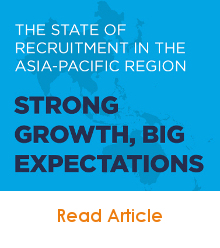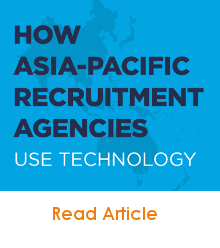Bullhorn Insights: Challenges Facing APAC Recruiters

Throughout 2016, Bullhorn surveyed over 100 APAC based agencies. Based on this data, we’ve summarised the key challenges facing APAC recruiters. Let’s take a look at some of the top challenges APAC-based recruitment agencies are facing today.
The Skills Shortage
When it comes to recruiter challenges, Bullhorn survey data revealed a painpoint that spanned countries, sectors and agency types. Participants were asked whether there was a shortage of skilled candidates in the sectors for which they recruited – and a whopping 88% answered in the affirmative.
Clearly, a deficit of talent is affecting multiple industries – and it’s posing a major issue for a significant number of APAC recruiters.
Which sectors are hardest hit by skills shortages?
Diving deeper into the data collected, we can reveal that 86% of respondents recruiting for the technology sector stated they faced a skills shortage, while for those recruiting for the financial industry, this figure was even higher, at 89%. So what’s causing a dearth of skilled candidates in these sectors?
For starters, demand is clearly outstripping talent supply when it comes to tech and finance. Australia’s Digital Pulse reports that the contribution of digital technologies to the Australian economy is forecast to grow by more than 75% by the year 2020, yet there has been a significant decline in the number of graduates with ICT qualifications over the last decade.
In the financial sector – which has seen a steady increase in demand for skilled finance professionals – a talent shortage has been made more problematic by lengthy recruitment processes, due to the need for candidates to prove their qualifications prior to being shortlisted. Furthermore – and perhaps linked to the frustration of this process – many highly-skilled workers are opting to set up their own businesses rather than seek employment within their industry.
For recruiters operating within sectors where talent is thin on the ground, the challenge is clear: how can you overcome this shortage of skilled candidates and attract the best talent to fill your placements?
Using Technology to Attract Top Talent
In a barren talent landscape, recruitment technology can provide the competitive edge needed to obtain winning applicants. But are recruitment agencies utilising the wealth of available digital tools effectively to enable them to stay ahead in the talent stakes?
Interestingly, while more than 20% of respondents questioned in Bullhorn surveys indicated they did not use CRM software to manage candidates, those who did ranked “placing existing candidates from recruitment CRM” as the number one source for yielding the best candidates for jobs.
This data suggests there is a big opportunity for APAC recruiters to leverage the benefits of CRM software to enhance their recruitment efforts. And for those who already employ a CRM solution, there could still be room for improvement – financial sector respondents (89% of whom cited a skills shortage in their industry) placed CRM as the third most successful placement source, indicating their CRM could be put to better use.
From automating processes to streamlining workflows, recruitment CRM solutions can offer a myriad of benefits to time-poor recruiters, not least the ability to spend more time on talent sourcing strategies.
In addition, data-driven technology can pave the way for data-focused recruiting, allowing recruiters to minimise wasted resources and engage in a more targeted approach. Using recruitment technology in this way can empower recruiters with valuable insights that enable them to identify the most effective talent sourcing methods.
A Stronger Brand Image
Perhaps the world’s most prolific tech company, Google certainly isn’t experiencing the talent shortage faced by its technology industry peers; for every one of its 5000 annual hires, the search engine behemoth receives more than 600 applications. How has Google managed to buck the skills deficit trend in such spectacular fashion?
Consistently named as one of the world’s best places to work, Google has firmly established itself as a workplace of choice for tech-savvy Millennials, and made its office-based perks and company culture a distinctive part of its brand image. When it comes to attracting top industry talent, this idea of a strong brand image can be leveraged by APAC recruiters in different ways.
Firstly, think about how you can positively promote your client’s “brand” in the job description. An attractive brand image can prove a big help in the desirability stakes, particularly when focusing on enticing elements of a company’s workplace and culture.
Secondly, consider whether your own company brand could use some work. Does it resonate with talented professionals in the industry you’re recruiting for? Is it strong enough to stand out against your competitors and get noticed by your target audience? To maximise your chances of being seen by skilled candidates, you’ll want to make sure your brand is prominent on the online and offline channels most popular with your industry talent.
Reaching Talent Far and Wide
When skilled candidates are in short supply, it’s more important than ever to ensure your efforts are reaching as many suitably skilled applicants as possible.
Adding new tactics to your traditional recruitment mix could help you attract talented job seekers who might not otherwise have been aware of the opening. For example, harnessing social media for recruitment can help you quickly expand your reach and provide visibility in front of a much wider audience.
Even if social media is already part of your mix, the ever-changing nature of the online world means regularly reviewing your digital activity is crucial to stay ahead. You may find your social media efforts would benefit from being more targeted, or your online brand needs to be strengthened in order to maximise the opportunities afforded by digital channels.
It also pays to think broader. If you’ve been focusing your efforts on a relatively narrow field, it might be time to expand your horizons. Let’s say you’ve been solely targeting ICT graduates to fill an ICT position – the fact that 43% of ICT workers studied courses other than ICT highlights the importance of thinking outside the qualification box.
The same applies to geographical location. When hot talent is in high demand, it might pay off to see whether the role in question could be filled with a skilled remote worker in another location, rather than a lesser skilled local applicant, thereby opening up opportunities to leverage a much larger pool of talent.
While there’s no denying that an industry skills shortage can pose an additional challenge for APAC recruiters, those who continually strive for new and innovative ways to stay ahead of the competition will be the ones who ultimately attract their industry’s top talent.
Want more trends? Take a look at our 2016 trends infographics:







